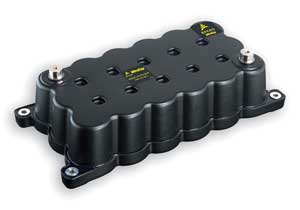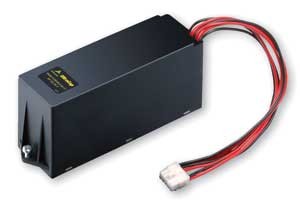Super capacitors
This article refers to the address: http://
The shortage of electricity and fuel has led people to look for more alternative energy sources. Supercapacitors make up for the technical gap between aluminum electrolytic capacitors and rechargeable batteries, while overcoming the shortcomings of both. Unlike conventional battery systems, they are capable of charging and discharging at very high currents without aging. The supercapacitor's thermal response capability is also superior to that of the battery system. It has a charge and discharge frequency of up to 500,000 times and has a long service life. Since the supercapacitor is not charged by a chemical reaction, but is charged by accumulating charges on the surface of the conductive carbon particles, its charging current can be very high, which is impossible for the battery because the battery itself has a very high High internal resistance. Battery charging is an electrochemical reaction process that is limited by reaction kinetics, while supercapacitors have no charging time limitations.
As an excellent technical solution for current alternative energy applications, supercapacitors are emerging in new technologies that require more efficient and reliable power supplies.

Figure 1 Similar to this supercapacitor module with 18 cell 42V package is entering the current and future automotive applications
The energy stored in a supercapacitor can be used in three main ways:
It can feed the automotive electrical system and reduce the burden on the on-board generator;
Pure reinforcement, that is to say, increase the torque of the motor and increase the acceleration when shifting;
Start assist: Enables the motor to start the acceleration car from a fixed state. This can save a lot of energy in some special operations that require repeated start and stop.
Hybrid energy vehicles and supercapacitors
The role of supercapacitors in the field of hybrid energy technology vehicles is very important. As energy prices continue to rise and European automakers commit to reduce their CO2 emissions by 25% between 1995 and 2008, these have contributed to the development of hybrid energy technologies. BMW, Mercedes-Benz and General Motors have formed a global alliance to jointly develop hybrid energy technologies.
Hybrid vehicles can be divided into three categories: light mixing, medium mixing, and full mixing. The slightly hybrid uses a more powerful starter that shuts down the engine when it stops and restarts the engine when it accelerates again. This small improvement can save 8% of energy in urban driving conditions while significantly reducing exhaust emissions.
Another improvement is the moderate mixing technique, which uses an electric motor to increase its acceleration in the first 30 seconds after the car stops to accelerate. This technology requires large-scale storage of renewable energy, which is easily achieved through the use of supercapacitors, saving 15% of fuel in urban driving conditions that require repeated start and stop.
Finally, fully hybrid energy technology will equip the car with a more powerful electric motor and high-energy battery, generating up to 75 kW of power, enabling full electric propulsion during short-range acceleration. This design can save 20% of energy.
Many of these new technologies will use alternative energy sources such as solar, wind or fuel cells. However, due to the characteristics of the energy source itself, it is determined that these power generation methods tend to have unevenness, and the power output is likely to change.
As the intensity of wind and sunlight changes, the output of the energy produced by these sources will change accordingly. This requires the use of a buffer to store energy.
Since the energy output generated by these energy sources may not meet the peak energy demand of the consumer side, the energy buffer can be used to provide the required peak power in a short time until the power generation is increased and the demand is reduced. In addition, energy buffers can also be used where the energy generation process is stable and the demand is constantly changing.
In the field of automotive drives using alternative energy technologies, supercapacitors are also a new type of key component. In a fuel cell-powered car, if a supercapacitor is used in combination, the fuel cell can meet the demand for continuous power, not just the peak supply.
In addition to meeting peak power requirements, supercapacitors have unmatched response times from other devices. Combining the power of supercapacitors with fuel cells results in a fuel cell system that is smaller, lighter, and less expensive.
The perfect combination of supercapacitors and hydrogen fuel cells
Hydrogen fuel cells, which are in the development stage, can be used in many fields. This hydrogen fuel cell is different from wind or solar energy, and as long as it has hydrogen fuel, it can continuously output stable electric energy.
However, the energy requirements of some applications vary widely over time. Cars are a direct example because they require much more energy during acceleration than at a constant speed. If there is no energy storage, the hydrogen fuel cell will have to be large to meet the highest peak energy demand, and the cost will be too large to bear. By storing excess energy in the energy store, the required peak energy can be supplied through the memory in a short time.

Figure 2 Supercapacitors are also well suited for use as backup batteries in industrial applications such as emergency lighting and automated equipment.
Hybrid internal combustion/electric vehicles are an important step in the era of fuel cell vehicles because the real drive components are electrically powered. Of course, an all-electric vehicle with a battery is also a solution, but the driving range of an all-electric vehicle is very limited. Compared to the time required to add fuel to an internal combustion engine or fuel cell, it takes longer for an all-electric vehicle to recharge.
For these reasons, many automakers initially chose to produce hybrid vehicles. This gives them the opportunity to further research and improve the electronic drivers and regeneration systems required for efficient fuel cell systems.
Regeneration means recoverable interruptions and recaptures kinetic energy during downhill taxiing. During braking and deceleration, the reduced kinetic energy of ordinary gasoline or diesel vehicles is lost in the form of brake heat and mechanical wear. Rather than throwing away this energy, it's better to recapture a large portion of the energy and store it for acceleration. When a car weighing about one ton travels at 35 mph, it suddenly loses about 100 kW of energy when it stops, and the energy is likely to be re-stored.
Description of Fidget Sleeve Toys for Reducing Stress
Fidget sleeve toys give the hands something to do so the mind can relax and focus on the task. Squeeze or slide the marble back and forth, or squeeze the sleeve together to roll the marble around. Silent and strong they are enjoyable and easy to use. QUALITY Made with high-quality, BPA-free plastic and premium marbles (meeting all toy safety standards), These fidget toys are durable and safe for kids and adults alike. Fidget toys are great for all children and adults, but especially those with ADD/ADHD, OCD, autism, or high stress / anxiety levels.
Features of Fidget Sleeve Toys for Reducing Stress
1. Light weight & Flexible & Insulation & UV Resistant & Decoration & Flame-retardant & Durable abrasion resistance & Resistant to chemical degradation, in a wide range of industrial applications.
2. Braided of 0.25mm / 0.2mm Pet monofilament.
3. The open weave construction allows an easy installation on a bundle of hoses and cables, even if some with bulky or large connectors.
Fidget Toy Sleeve,Reduce Stress Sleeve Toy ,Stress Relief Sleeve Toy,Sleeve For Fidget Toys
Shenzhen Huiyunhai Tech.Co.,Ltd , https://www.hyhbraidedsleeve.com